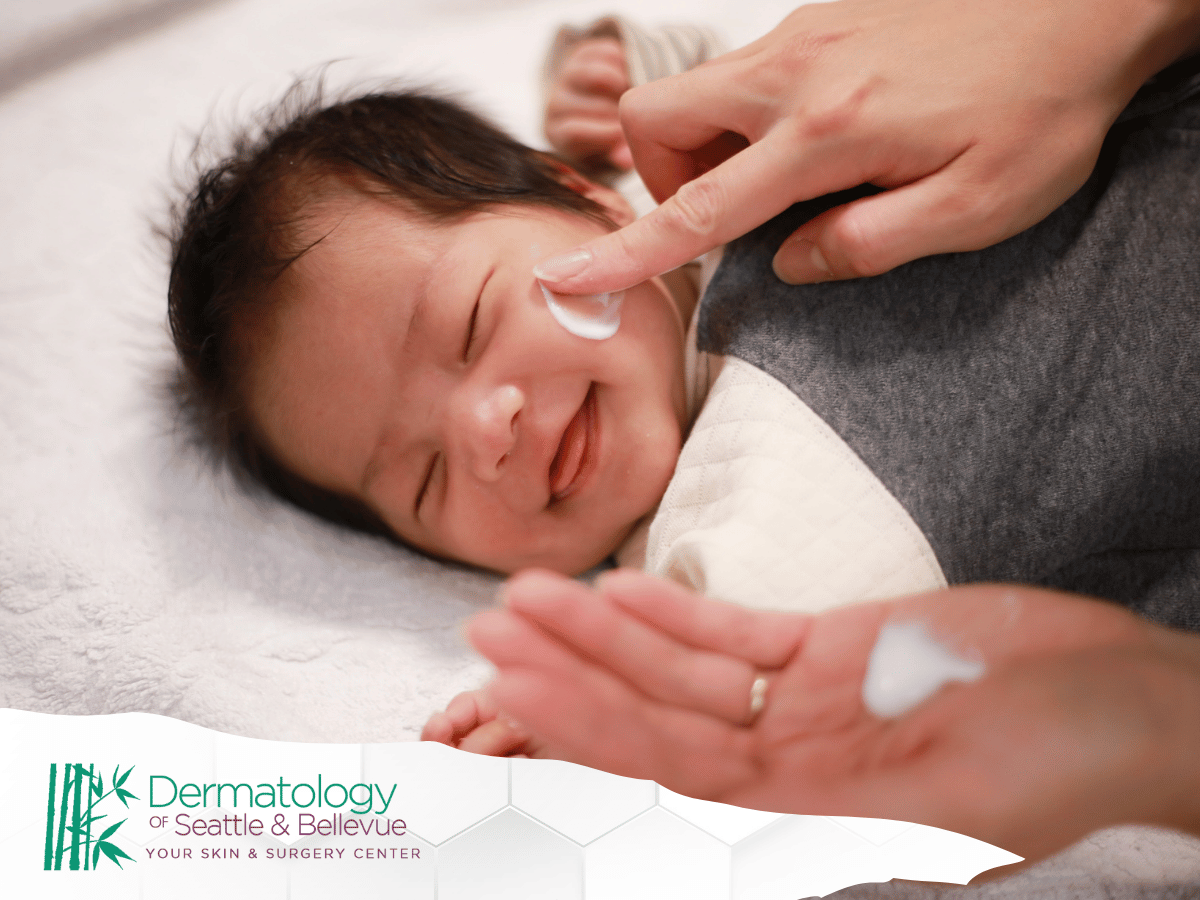A newborn’s skin is delicate, soft, and constantly adapting to life outside the womb. While that baby-soft glow is every parent’s dream, it often comes with challenges like dryness, sensitivity, and occasional rashes. For Bellevue parents, understanding how to care for infant skin can make all the difference in keeping it healthy, protected, and comfortable.
This guide explores common newborn skin issues, prevention strategies, and safe treatments—so you can confidently nurture your baby’s skin from day one.
Understanding Newborn Skin
Your baby’s skin is more than just soft—it’s also incredibly complex and sensitive. During the first few months, it undergoes rapid development as it learns to regulate moisture, temperature, and protect against environmental irritants.
Proper care during this time not only prevents discomfort but also lays the foundation for lifelong skin health.
Why Newborn Skin Is Different
Newborn skin is about 30% thinner than adult skin, making it more prone to irritation, dryness, and rash development. The top layer (the stratum corneum) is still maturing, which means it doesn’t yet provide a fully effective barrier against friction, allergens, or bacteria.
This is why parents often notice redness, peeling, or tiny bumps in the first few weeks—it’s a normal adjustment process as the skin adapts to the new environment. Using gentle, fragrance-free products is essential during this stage to protect the developing skin barrier.
How The Skin Barrier Develops In Infants
In the first six months, a baby’s skin works hard to form a strong moisture barrier. This layer helps retain hydration and protect against external irritants, but it’s still fragile in newborns. Factors like dry indoor air, frequent bathing, and harsh soaps can easily disrupt it, leading to irritation or rashes.
Dermatologists recommend keeping skincare minimal during this stage. Focus on short, lukewarm baths, mild cleansers, and gentle moisturizers that reinforce the skin’s natural defenses rather than strip them away. Over time, the skin barrier strengthens, making the skin more resilient against everyday stressors.
Common Baby Rashes Explained
Even with the best care, most infants experience a few rashes early on—it’s part of normal skin development. From diaper rash to cradle cap, these temporary irritations can look concerning but are often harmless and easily managed at home.
Knowing how to identify and respond to each type of rash helps parents act quickly and prevents unnecessary discomfort for their newborns.
Diaper Rash
Diaper rash is one of the most common forms of newborn skin irritation. It occurs when prolonged moisture, friction, and contact with urine or stool irritate the delicate skin around the diaper area. Redness, small bumps, or shiny patches are typical signs.
To prevent it, change diapers frequently and allow the area to air dry before applying a moisture barrier cream containing zinc oxide or petroleum jelly. Avoid scented wipes and consider using lukewarm water with a soft cloth instead. If the rash doesn’t improve within a few days or worsens, it could be a yeast infection—something your dermatologist can easily diagnose and treat.
Diaper rash prevention tips:
- Change diapers promptly after each use
- Use breathable, absorbent diaper materials
- Apply moisture barrier cream regularly
- Give the skin diaper-free time to breathe
Cradle Cap
Cradle cap, or seborrheic dermatitis, appears as flaky, yellowish patches on a baby’s scalp, forehead, or behind the ears. Though it might look concerning, it’s not painful or contagious. This condition develops due to overactive oil glands and typically clears up within the first few months.
Gently massaging your baby’s scalp with a soft brush and mild baby shampoo can help loosen the flakes. For stubborn cases, a pediatric dermatologist may recommend a light application of mineral oil or a medicated shampoo.
To help prevent cradle cap:
- Gently brush your baby’s scalp daily
- Avoid harsh or fragranced shampoos
- Use gentle moisturizing oils sparingly
Baby Acne
Baby acne often shows up as small red or white bumps on the face, especially on the cheeks and forehead. It usually appears around 2–4 weeks after birth and resolves on its own within a few months. Unlike adult acne, it isn’t caused by clogged pores but rather by maternal hormones still circulating in the baby’s system.
The best approach is patience—avoid scrubbing, squeezing, or applying creams unless advised by a dermatologist. Keeping the baby’s skin clean and dry with mild, fragrance-free cleansers is typically enough.
Heat Rash And Eczema
Heat rash (miliaria) appears as tiny pink or red bumps, often on the neck, chest, or diaper area. It happens when sweat gets trapped under the skin, especially in warm or humid conditions. Light, breathable clothing and a cool environment usually resolve it quickly.
Eczema (atopic dermatitis), on the other hand, is a more persistent condition that causes dry, itchy, inflamed patches on the skin. Babies with a family history of allergies or asthma are more prone to it. Moisturizing regularly and avoiding scented products can help reduce flare-ups.
Quick relief strategies:
- Keep your baby cool and dry
- Dress in breathable cotton fabrics
- Apply gentle, fragrance-free moisturizers twice daily
- Consult a dermatologist if rashes persist or spread
Prevention: Building A Healthy Baby Skincare Routine
Choosing Gentle, Organic Baby Skincare Products
When it comes to baby skincare, less is more—especially in the first few months. Opt for products labeled as hypoallergenic, fragrance-free, and dermatologist-tested. Organic baby skincare lines can be a great choice, but always check that ingredients are simple and non-irritating. Natural doesn’t always mean safe; some botanical ingredients can still cause sensitivity.
Stick to mild cleansers, simple moisturizers, and minimal additives. Look for products with ingredients like shea butter, coconut oil, or ceramides, which help strengthen your baby’s developing skin barrier while keeping it hydrated.
Using Moisture Barrier Cream Effectively
A moisture barrier cream is your baby’s best defense against dryness, irritation, and rashes. These creams create a protective layer that locks in moisture and shields delicate skin from friction, drool, or diaper moisture.
For diaper rash prevention, apply a thin layer of cream—like one containing zinc oxide—after each diaper change. For dry patches elsewhere, use a lighter, fragrance-free formula to avoid clogging pores. The key is consistency; applying barrier cream regularly helps maintain soft, healthy skin and prevents new irritations from forming.
When and where to use barrier creams:
- After every diaper change
- On cheeks during cold or windy weather
- On areas prone to dryness (knees, elbows, folds)
Bathing And Moisturizing Tips
Bathing routines are an essential part of infant skincare—but overdoing it can dry out sensitive skin. Newborns typically only need a bath two to three times a week during the first few months. Between baths, clean gently with a damp cloth as needed.
Use lukewarm water and mild, fragrance-free baby cleansers. Pat the skin dry instead of rubbing, and apply moisturizer immediately after to seal in hydration. For babies with eczema or dryness, adding a few drops of baby-safe oil to bathwater can help maintain moisture balance.
Treating Newborn Rashes Safely
When To Use Over-The-Counter Products
Most mild newborn rashes clear up on their own, but some over-the-counter (OTC) remedies can provide relief and speed healing. Always choose formulas made specifically for babies and avoid any product containing alcohol, fragrance, or strong active ingredients.
Hydrocortisone creams (0.5% or 1%) can sometimes be used for mild eczema or irritation, but only under pediatric guidance. For diaper rash, barrier creams with zinc oxide or petroleum jelly are safe and effective. If a rash spreads, becomes oozing or crusted, or doesn’t improve within a few days, it’s time to get a professional opinion.
Safe OTC options for infants include:
- Zinc oxide or petroleum-based diaper creams
- Mild baby moisturizers with ceramides
- Soothing ointments for dry patches
- Fragrance-free cleansers and shampoos
Signs It’s Time To Call A Dermatologist
While most baby rashes are harmless, certain symptoms warrant a professional evaluation. Persistent, spreading, or painful rashes could indicate an infection or allergic reaction. If your baby develops blisters, fever, or swelling, schedule a dermatology visit immediately.
Parents in Bellevue often visit Dermatology of Seattle for reassurance and expert diagnosis when unsure whether a rash is normal. Pediatric dermatologists can identify the cause quickly and recommend gentle, targeted treatment options to relieve discomfort safely.
You should call a dermatologist if you notice:
- Rashes that don’t improve with home care
- Oozing, crusting, or bleeding skin
- Fever or swelling accompanying a rash
- Extreme dryness or thickened patches
Lifestyle And Environmental Tips For Sensitive Baby Skin
Ideal Clothing And Fabrics For Newborns
Clothing plays a bigger role in skin health than most parents realize. The right fabrics help reduce irritation and keep skin cool, while harsh materials can worsen rashes. Soft, breathable fabrics like cotton or bamboo are ideal for everyday wear. Avoid wool, synthetic blends, or tight-fitting outfits that trap heat and moisture.
When washing baby clothes, use a gentle, fragrance-free detergent and skip fabric softeners, which often contain irritants. Keeping fabrics clean and simple supports the skin’s natural healing process and helps prevent flare-ups.
Best fabric choices for sensitive baby skin:
- 100% cotton or bamboo materials
- Loose, breathable fits
- Washed in hypoallergenic detergent
- Avoided harsh dyes or prints touching skin
How To Control Humidity And Temperature At Home
Maintaining the right home environment is one of the easiest ways to protect your baby’s sensitive skin. Bellevue’s cool, often dry climate can strip moisture from newborn skin, leading to flaking or irritation. Using a humidifier helps keep indoor air comfortably moist, preventing dryness and reducing the risk of eczema flare-ups.
Keep room temperatures moderate—around 68–72°F (20–22°C)—and avoid overheating with too many blankets or layers. Overheating can cause sweating, which may trigger heat rash. Proper airflow, breathable fabrics, and consistent humidity make a big difference in keeping your baby’s skin soft, calm, and rash-free.
Home environment tips for healthy skin:
- Use a cool-mist humidifier, especially in winter
- Avoid extreme room temperatures
- Dress in breathable layers
- Keep air clean and well-circulated
When To Seek Professional Guidance
Even with the best preventive care, some rashes and irritations may require medical attention. Persistent or recurring skin issues could signal an underlying sensitivity, allergy, or dermatologic condition that needs professional treatment.
If your baby’s rash worsens or new symptoms develop—such as oozing, scaling, or persistent redness—schedule a visit with a board-certified dermatologist. A specialist can identify whether it’s eczema, allergic dermatitis, or an infection, and recommend treatments that are safe for your baby’s age and skin type.
Early professional care not only relieves your baby’s discomfort but also helps parents feel confident in managing future skin concerns effectively.
What To Expect During A Pediatric Dermatology Visit
A visit to a pediatric dermatologist is gentle, reassuring, and focused on your baby’s comfort. During the appointment, the provider will carefully examine your baby’s skin, discuss your observations, and review products or routines you’re currently using.
They may recommend specific moisturizers, barrier creams, or prescription-strength ointments depending on the condition. Most treatments for newborns are topical and non-invasive, designed to soothe rather than aggressively treat. You’ll also receive personalized care tips to help prevent future flare-ups at home.
At Dermatology of Seattle, parents appreciate the thorough, compassionate approach—combining medical expertise with practical education to keep newborn skin happy and healthy.
Conclusion: Keeping Your Newborn’s Skin Happy And Healthy
Your baby’s skin deserves gentle, thoughtful care—especially during those first few months when it’s still developing its natural defenses. By keeping routines simple, choosing mild and safe products, and maintaining a comfortable environment, you can help prevent most common rashes and irritations.
And remember, every baby’s skin is unique. If something doesn’t seem right or a rash doesn’t clear up quickly, professional help is just a call away. At Dermatology of Seattle & Bellevue, our dermatologists specialize in pediatric skin care, offering parents peace of mind and tailored guidance to keep their little one’s skin soft, healthy, and protected.
Disclaimer
This article is for informational purposes only and does not replace professional medical advice. Always consult a qualified dermatologist or pediatrician for concerns about your baby’s skin or any persistent rashes.





